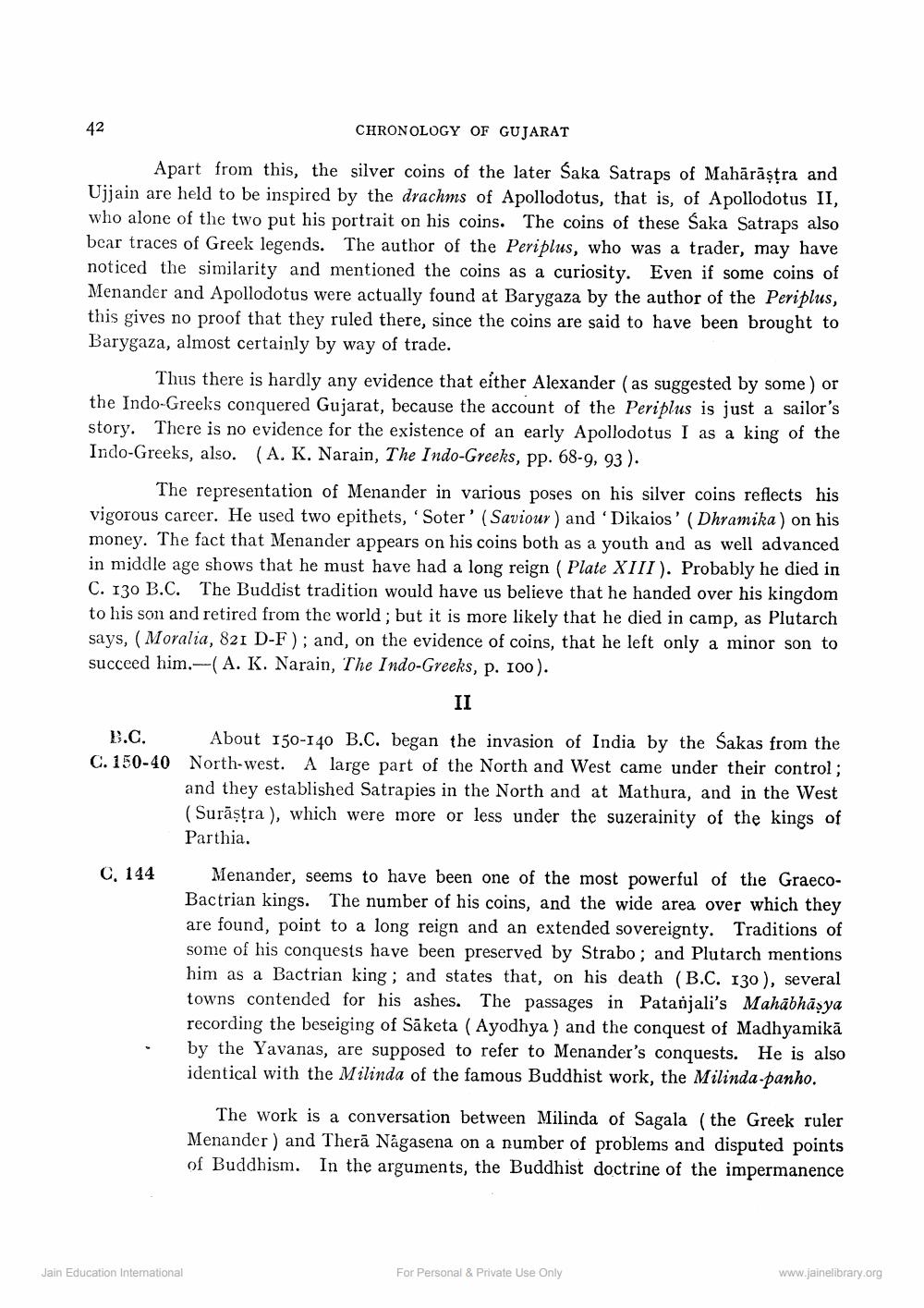________________
CHRONOLOGY OF GUJARAT
Apart from this, the silver coins of the later Śaka Satraps of Mahārāșțra and Ujjain are held to be inspired by the drachms of Apollodotus, that is, of Apollodotus II, who alone of the two put his portrait on his coins. The coins of these saka Satraps also bear traces of Greek legends. The author of the Periplus, who was a trader, may have noticed the similarity and mentioned the coins as a curiosity. Even if some coins of Menander and Apollodotus were actually found at Barygaza by the author of the Periplus, this gives no proof that they ruled there, since the coins are said to have been brought to Barygaza, almost certainly by way of trade.
Thus there is hardly any evidence that either Alexander (as suggested by some ) or the Indo-Greeks conquered Gujarat, because the account of the Periplus is just a sailor's story. There is no evidence for the existence of an early Apollodotus I as a king of the Indo-Greeks, also. (A. K. Narain, The Indo-Greeks, pp. 68-9, 93).
The representation of Menander in various poses on his silver coins reflects his vigorous career. He used two epithets, 'Soter' (Saviour ) and 'Dikaios' (Dhramika) on his money. The fact that Menander appears on his coins both as a youth and as well advanced in middle age shows that he must have had a long reign ( Plate XIII). Probably he died in C. 130 B.C. The Buddist tradition would have us believe that he handed over his kingdom to his son and retired from the world; but it is more likely that he died in camp, as Plutarch says, (Moralia, 821 D-F); and, on the evidence of coins, that he left only a minor son to succeed him.--(A. K. Narain, The Indo-Greeks, p. 100).
II
B.C. About 150-140 B.C. began the invasion of India by the Sakas from the C. 150-40 North-west. A large part of the North and West came under their control;
and they established Satrapies in the North and at Mathura, and in the West (Surāșțra ), which were more or less under the suzerainity of the kings of Parthia.
C, 144
Menander, seems to have been one of the most powerful of the GraecoBactrian kings. The number of his coins, and the wide area over which they are found, point to a long reign and an extended sovereignty. Traditions of some of his conquests have been preserved by Strabo ; and Plutarch mentions him as a Bactrian king; and states that, on his death (B.C. 130 ), several towns contended for his ashes. The passages in Patanjali's Mahābhāşya recording the beseiging of Sāketa ( Ayodhya ) and the conquest of Madhyamikā by the Yavanas, are supposed to refer to Menander's conquests. He is also identical with the Milinda of the famous Buddhist work, the Milinda.panho.
The work is a conversation between Milinda of Sagala (the Greek ruler Menander) and Therā Nāgasena on a number of problems and disputed points of Buddhism. In the arguments, the Buddhist doctrine of the impermanence
Jain Education International
www.jainelibrary.org
For Personal & Private Use Only




